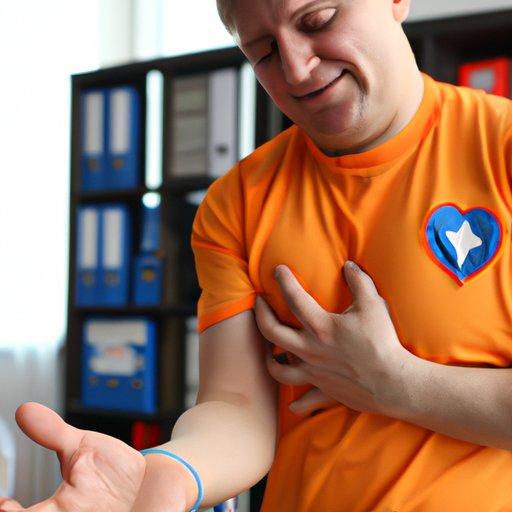
Introduction
Cardiac arrest is a condition where the heart suddenly stops beating, leaving an individual unresponsive and, if left untreated, can be fatal. It can happen to anyone at any time, regardless of age, health or fitness level. According to the American Heart Association, over 350,000 cardiac arrests occur outside of a hospital each year in the United States. It’s a silent killer that takes countless lives every day. In this article, we will explore what you need to know to survive cardiac arrest.
Cardiac Arrest: The Silent Killer and What You Need to Know to Survive It
Cardiac arrest is caused by a malfunction in the electrical system of the heart, leading to an irregular heartbeat. Many factors can contribute to sudden cardiac arrest, including:
- Coronary artery disease
- Heart attack
- Cardiomyopathy
- Heart rhythm disorders
- Drug abuse
Some common symptoms of cardiac arrest include:
- Chest pain
- Fainting or loss of consciousness
- Shortness of breath
- Palpitations or irregular heartbeat
- Weakness or fatigue
If you witness someone experiencing cardiac arrest, it’s crucial to act quickly. You can significantly increase their chances of survival by following these steps:
- Call 911 or emergency medical services immediately
- Begin CPR, even if you’re not trained. Hands-only CPR can be performed by pressing hard and fast in the center of the chest.
- Use an automated external defibrillator (AED) if available.
- Wait for medical personnel to arrive and take over.
There are also several strategies to increase the chances of survival during cardiac arrest. These include:
- Knowing the signs and symptoms of cardiac arrest
- Maintaining a healthy lifestyle, including regular exercise, a balanced diet, and maintaining healthy cholesterol, blood pressure and glucose levels.
- Managing stress levels through techniques such as meditation, exercise or therapy.
- Regular medical check-ups to monitor heart health and detect any issues early on.
The Role of CPR in Surviving Cardiac Arrest
CPR (cardiopulmonary resuscitation) is a life-saving technique that helps to keep blood and oxygen moving throughout the body. It’s crucial during cardiac arrest for several reasons:
- It helps to keep vital organs functioning during a time when the heart has stopped.
- It buys time until emergency personnel can arrive to take over.
- It can help to restart the heart in some cases.
Performing CPR is relatively easy, and anyone can learn how to do it. Here are the basic steps involved in CPR:
- Place the patient on a firm surface and tilt their head back.
- Place the heel of one hand on the center of their chest, and place the other hand on top of the first.
- Push hard and fast on the chest, compressing to a depth of 2 inches.
- Continue performing compressions at a rate of 100-120 per minute until emergency medical services arrive or until the patient begins to respond.
There are some tips that can help to perform CPR effectively:
- Don’t be afraid to push hard and fast on the chest. You need to compress the chest firmly to be effective.
- Allow the chest to recoil fully after each compression.
- Don’t worry about giving mouth-to-mouth during CPR – hands-only CPR is just as effective.
- Switch with another person every two minutes to avoid fatigue.
Surviving a Heart Attack: Tips to Keep You Alive
While cardiac arrest can happen unexpectedly, there are several things you can do to reduce your risk of developing heart disease and suffering a heart attack:
- Quit smoking and avoid exposure to secondhand smoke
- Maintain a healthy weight and body mass index (BMI)
- Eat a diet rich in fruits, vegetables, whole grains, and lean protein
- Reduce your salt and sugar intake
- Exercise regularly – aim for at least 150 minutes of moderate exercise per week
- Stay hydrated and limit alcohol intake
- Manage chronic conditions such as high blood pressure, diabetes, and high cholesterol
- Get enough sleep every night and manage stress through techniques such as meditation, deep breathing, or exercise
The Science Behind Surviving Cardiac Arrest: What Happens to Your Body?
Cardiac arrest is a complex medical event that can lead to significant physical changes in the body.
- During cardiac arrest, blood stops flowing through the body, leading to oxygen deprivation in vital organs such as the brain, heart and lungs.
- The cessation of blood flow also means that waste products start to accumulate in the body, leading to tissue damage and other complications.
- Survival rates depend on many factors, including the initial cause of the arrest, how quickly treatment is administered, and the overall health and age of the patient.
- In recent years, technological advances such as hypothermia treatment and new drugs have shown promise in improving survival rates.
Life After Cardiac Arrest: Coping Strategies and What to Expect
Cardiac arrest can be a frightening and traumatic experience, not only for the individual who suffers from it but also for their loved ones.
- Early intervention and effective treatment can lead to a more speedy recovery and a better overall quality of life.
- Many cardiac arrest survivors experience physical and emotional challenges after the event, such as memory loss, fatigue, depression, and anxiety.
- It’s essential to seek out support from friends, family, and medical professionals to cope with the aftermath of cardiac arrest.
- After recovering from cardiac arrest, it’s important to make lifestyle changes to reduce the risk of further cardiac events.
Conclusion
Cardiac arrest is a serious and life-threatening medical condition, but with the right knowledge and strategies, it’s possible to survive and recover. Knowing the signs and symptoms of cardiac arrest, performing CPR as necessary, and making lifestyle changes to reduce the risk of heart disease and cardiac arrest are essential elements to surviving cardiac arrest. Seek professional help and support as needed, and follow the advice of healthcare professional to ensure a healthy and fulfilling life.





